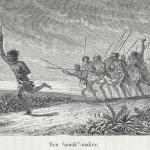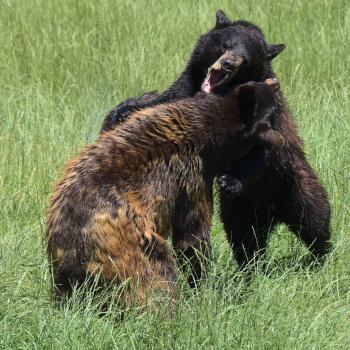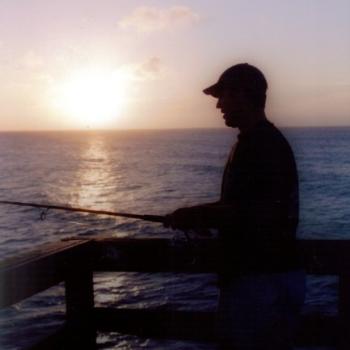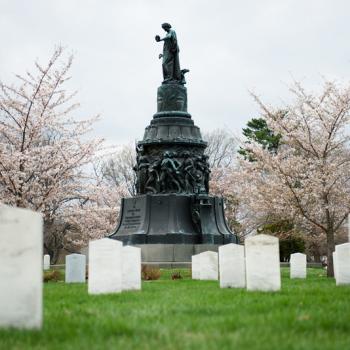I was nine years old, give or take a year or two, and I was home sick from school. Mom went to the local branch of the Baltimore County Public Library (all praise be upon it, and upon Mom) and came back with some books for me.
I supposed she asked the librarian for something appropriate for my young age, advanced reading level, and interest in science fiction and fantasy. Among the books she brought home was Ursula K. Le Guin’s The Tombs of Atuan.
It is the story of the priestess Tenar, taken from her parents as a girl as the reincarnation of the priestess of Nameless Ones, the dark powers of the Tombs of Atuan; and of the wizard Ged who comes to those tombs on a quest to restore peace and wholeness to his own land by stealing a magical talisman from the Tombs. Rather than killing Ged as she is supposed to, Tenar allows him to live, and in turn he frees her from the captivity of her priestesshood.
The Tombs of Atuan is the second book in the Earthsea series. I hate coming in in the middle of the story, so next time I was at the library I borrowed the first book, A Wizard of Earthsea. It tells how the boy Sparrowhawk grew into the wizard Ged. It is a coming-of-age story in a sword-and-sorcery universe, but one that is about the hero coming to terms with himself rather than defeating some Dark Lord. It has remained a favorite ever since, and I re-read it every few years.
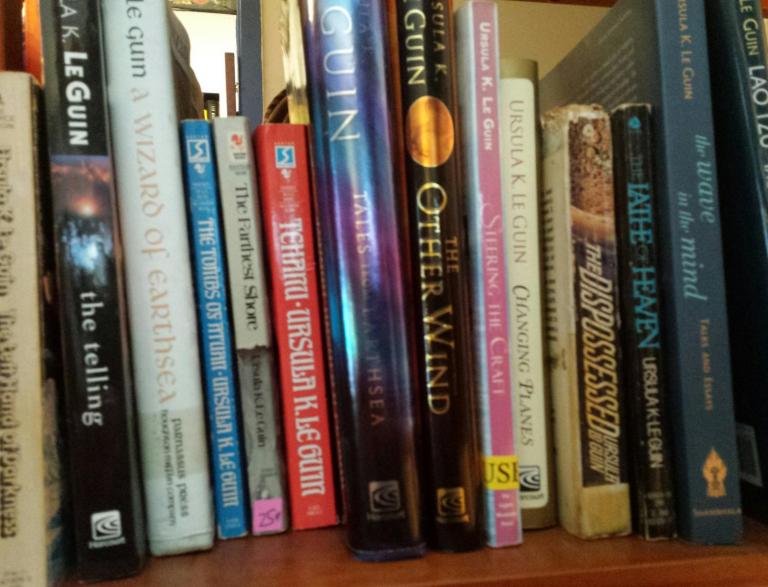 The third book of the original trilogy, The Farthest Shore, takes Ged the Archmage on a quest that leads him through the land of the dead, where he must give up all his power in order to heal the world. But along the way he teaches a young man to be a king, and thus fulfills the promise of peace in the realm set up by his quest to the tombs of Atuan years before.
The third book of the original trilogy, The Farthest Shore, takes Ged the Archmage on a quest that leads him through the land of the dead, where he must give up all his power in order to heal the world. But along the way he teaches a young man to be a king, and thus fulfills the promise of peace in the realm set up by his quest to the tombs of Atuan years before.
So in this trilogy, we see Ged grow from an impetuous boy who from pride brings doom on one he loves and nearly destroys himself, to a journeyman wizard who becomes a rescuer and a healer of the realm, to a master and mentor who helps the next generation along before flying off into the sunset on the back of a dragon. (Okay, Gont is actually northeast of Roke, but I can’t help but picture Kalessin flying into the sunset in that final scene of The Farthest Shore.)
I’ve written before about how Ged illustrates a model of the evolution of the magician I heard from Jeff “Magnus” McBride, developing from a Trickster, to the spectacle-oriented Sorcerer, to the more internally and psychologically focused Oracle, to the wisdom-dispensing Sage.
McBride was speaking in the context of stage magic, and used such examples as the huge spectacles of David Copperfield as the Sorcerer in action, while David Blaine, frozen still and unmoving in the middle of Times Square, is an example of the Oracle, turning inward.
But we can also apply this to fictional wizards working “real” magic in their universes. As a boy Ged is the Trickster who defends his village by summoning fog to confuse invading soldiers, then as a youth becomes the Sorcerer who, in competition with another student of magic to produce the most astonishing spectacle, summons powerful spirits on a dare — and is nearly killed by an evil he releases into the world. He then turns to an inward journey as Oracle as he struggles against his own failure and the shadow he has loosed. He emerges from his trials not merely a fighter with supernatural powers but truly a wizard, a wise one, who plays the Sage, the adviser and councilor, to the protagonists of the next two novels.
Many years later Le Guin added two novels and a volume of short stories to the Earthsea cycle, deepening that world with the tale of Tenar and Ged after Ged gives up his wizardry — but not his wisdom. The latter three books deal with the role of gender, the nature of magic, and the nature of death and the afterlife in the Earthsea universe.
Her other notable works include The Left Hand of Darkness, which in current parlance we might say “deconstructs” a lot of ideas about gender; The Dispossessed, which deconstructs notions about government and property; and The Lathe of Heaven, which takes up the Taoist notion that the world is not a thing to be taken up and controlled or ruled.
And there is her brilliant and heart-rending short short story, “The Ones Who Walk Away from Omelas”, about both the impossibility and the necessity of refusing to be part of injustice.
When I recently re-read the Earthsea cycle, I was particularly struck by something that Ged says to Tenar in The Tombs of Atuan: “Alone, no one wins freedom.” This points at a theme of solidarity and mutual aid that runs through a lot of Le Guin’s work.
But is there a bit of a paradox here? After all, isn’t freedom, in at least one sense, the right to be left alone? To make sense of this statement we must place it in context.
Ged says this to Tenar as they are struggling against both the supernatural powers of the Nameless Ones and the temporal powers of the Kargish temples. Separately, each of us is vulnerable to exploitation and oppression by the powerful.
Only in solidarity can we resist. So the right to be left alone, depends on others.
We are in a realm of Taoist paradox here. Le Guin compiled her own interpretation of the Tao Te Ching, which I recommend highly.
In The Dispossessed, the protagonist from an anarchist planet criticizes a capitalist society: “You are all in jail. Each alone, solitary, with a heap of what he owns. You live in prison, die in prison.” While in A Wizard of Earthsea, one of the Masters at the school of wizardry tells Ged:
You thought, as a boy, that a mage is one who can do anything. So I thought, once. So did we all. And the truth is that as a man’s real power grows and his knowledge widens, ever the way he can follow grows narrower: until at last he chooses nothing, but does only and wholly what he must do…
Power and riches and knowledge become imprisoning. Solidarity and compassion free us. In A Wizard of Earthsea, it is simple acts of compassion and trust that bring Ged back when he is near despair and death. In “The Ones Who Walk Away from Omelas”, it is compassion for the forsaken child upon whose misery the beauty of the society rests, that frees the leavers, though the result of their freedom is an uncertain thing. (Isn’t it always?)
Perhaps the wisest character in the Earthsea novels, mentor and father figure to both Ged and Tenar, is the wizard Ogion the Silent, a powerful and respected wizard who could have anything he wanted, but lives in a simple home tending his garden and his goats and walking the woods, very much in the model of a Taoist sage.
The Farthest Shore, the final novel of the original trilogy, deals with the land of the dead in the Earthsea universe. But Le Guin returns to the idea of death in the final novel of the expanded series, The Other Wind, resolving a conflict between this Hades-like afterlife where the spirits of Ged’s people go and where the dead persist forever as shadows of their former selves, and the reincarnation beliefs of Tenar’s Kargish people. The final part of the story of Earthsea is the restoration of the freedom to die, to disperse, to spread out into the universe.
Death has been much on my mind lately, and in rereading the series I was struck by two character’s statement on the topic. So I will leave Le Guin with the final words here.
From The Other Wind:
“I think,” Tehanu said in her soft, strange voice, “that when I die I breathe back the breath that made me live. I can give back to the world all that I didn’t do. All that I might have been and couldn’t be. All the choices I didn’t make. All the things I lost and spent and wasted. I can give them back to the world. To the lives that haven’t been lived yet. That will be my gift back to the world that gave me the life I did live, the love I loved, the breath I breathed.”
And from A Wizard of Earthsea:
“It is no secret. All power is one in source and end, I think. Years and distances, stars and candles, water and wind and wizardry, the craft in a man’s hand and the wisdom in a tree’s root: they all arise together. My name, and yours, and the true name of the sun, or a spring of water, or an unborn child, all are syllables of the great word that is very slowly spoken by the shining of the stars. There is no other power. No other name.”
Staying his knife on the carved wood, Murre asked, “What of death?’”
The girl listened, her shining black head bent down.
“For a word to be spoken,” Ged answered slowly, “there must be silence. Before, and after.”
b



